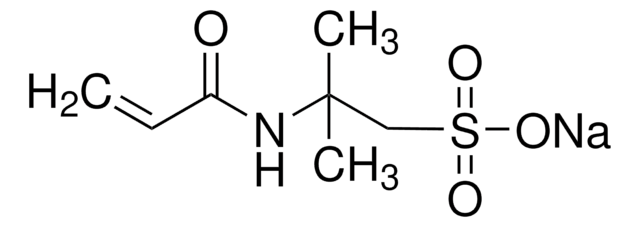추천 제품
양식
liquid
농도
80% in H2O
refractive index
n20/D 1.512
density
1.341 g/mL at 25 °C
SMILES string
[Cl-].OC[P+](CO)(CO)CO
InChI
1S/C4H12O4P.ClH/c5-1-9(2-6,3-7)4-8;/h5-8H,1-4H2;1H/q+1;/p-1
InChI key
AKXUUJCMWZFYMV-UHFFFAOYSA-M
유사한 제품을 찾으십니까? 방문 제품 비교 안내
관련 카테고리
애플리케이션
Tetrakis(hydroxymethyl)phosphonium chloride solution (80% in H2O) has been used as a reducing agent and stabilizing ligand for the synthesis of gold nanoparticles (AuNPs) from gold(III) chloride trihydrate (HAuCl4.3H2O). It is a tetra-functional, amine-reactive, aqueous crosslinker that can be used for tuning the properties of protein-based hydrogels for 3D cell encapsulation applications.
신호어
Danger
유해 및 위험 성명서
Hazard Classifications
Acute Tox. 3 Dermal - Acute Tox. 3 Oral - Aquatic Acute 1 - Aquatic Chronic 1 - Eye Dam. 1 - Met. Corr. 1 - Repr. 1B - Skin Corr. 1B - Skin Sens. 1
Storage Class Code
6.1A - Combustible acute toxic Cat. 1 and 2 / very toxic hazardous materials
WGK
WGK 3
Flash Point (°F)
Not applicable
Flash Point (°C)
Not applicable
개인 보호 장비
Eyeshields, Faceshields, Gloves, type ABEK (EN14387) respirator filter
이미 열람한 고객
Facile preparation of water-soluble fluorescent gold nanoclusters for cellular imaging applications.
Shang L, et al.
Nanoscale, 3(5), 2009-2014 (2011)
Beyond gold: rediscovering tetrakis-(hydroxymethyl)-phosphonium chloride (THPC) as an effective agent for the synthesis of ultra-small noble metal nanoparticles and Pt-containing nanoalloys
Hueso J L, et al.
Royal Society of Chemistry Advances, 3(26), 10427-10433 (2013)
Baris Karakullukcu et al.
Journal of biophotonics, 4(10), 740-751 (2011-08-24)
The objective quantitative monitoring of light, oxygen, and photosensitizer is challenging in clinical photodynamic therapy settings. We have previously developed fluorescence differential path-length spectroscopy (FDPS), a technique that utilizes reflectance spectroscopy to monitor microvascular oxygen saturation, blood volume fraction, and
Tobias Kiesslich et al.
Photochemical & photobiological sciences : Official journal of the European Photochemistry Association and the European Society for Photobiology, 9(5), 734-743 (2010-04-02)
Photodynamic therapy (PDT) using Photofrin and, recently, Foscan has gained broad acceptance for palliative treatment of non-resectable cholangiocarcinoma (CC). No information, however, is available whether the phenotype of CC tumour cells has an effect on the efficiency of the treatment.
D J Ball et al.
Journal of photochemistry and photobiology. B, Biology, 45(1), 28-35 (1998-11-20)
Three substituted zinc (II) phthalocyanines (one anionic, one cationic and one hydrophobic) have been compared to two clinically used photosensitisers, 5,10,15,20-tetra (m-hydroxyphenyl) chlorin (mTHPC) and polyhaematoporphyrin (PHP), as potential agents for photodynamic therapy (PDT). Oxygen-consumption experiments, performed to follow the
자사의 과학자팀은 생명 과학, 재료 과학, 화학 합성, 크로마토그래피, 분석 및 기타 많은 영역을 포함한 모든 과학 분야에 경험이 있습니다..
고객지원팀으로 연락바랍니다.
![Bis[tetrakis(hydroxymethyl)phosphonium] sulfate solution technical, 70-75% in H2O (T)](/deepweb/assets/sigmaaldrich/product/structures/236/818/d029a904-00ee-46ad-9fe2-2369f9894cc4/640/d029a904-00ee-46ad-9fe2-2369f9894cc4.png)

















